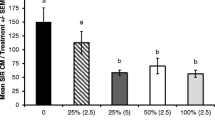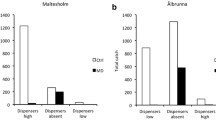Abstract
Pheromone-mediated mating disruption (MD) is widely used as a control tool to manage the European grapevine moth (EGVM), Lobesia botrana. Most of the MD formulations are “passive” reservoir dispensers, which need to be used at a rather large number of units per hectare. A promising alternative is represented by automatic aerosol devices, releasing pheromone puffs at programmed time intervals. Herein, we investigated the effectiveness of MD aerosol product Isonet® L MisterX841 in reducing EGVM infestation on grape in comparison to the reference MD product Isonet® L and the grower’s standard. Experiments were carried out over 2 years in two different study sites of Aragon region (Spain). EGVM male catches were monitored using traps baited with the female sex pheromone. The effectiveness of MD formulations against the three generations of EGVM was assessed by determining the percentage of infested bunches and the number of nests per bunch. As expected, a much greater amount of male catches in the grower’s standard over Isonet® L MisterX841 and Isonet ® L was observed. No significant differences about EGVM male catches were found in vineyards where Isonet® L MisterX841 and Isonet® L were used. EGVM-infested bunches, as well as number of nests per bunch, were higher in the grower’s standard, if compared to vineyards where we tested Isonet® L MisterX841 and Isonet® L. However, the employ of the latter led to a lower EGVM bunch infestation, if compared to Isonet® L MisterX841. Overall, the MD approach proposed here is effective against EGVM. These aerosol devices require a lower number of units per hectare if compared to hand-applied dispensers, saving labor costs and contributing to reduce plastic disposal in agricultural settings.



Similar content being viewed by others
References
Anfora G, Baldessari M, De Cristofaro A, Germinara GS, Ioriatti C, Reggiori F et al (2008) Control of Lobesia botrana (Lepidoptera: Tortricidae) by biodegradable Ecodian sex pheromone dispensers. J Econ Entomol 101:444–450
Baker TC, Ditt T, Mafra-Neto A (1997) Disruption of sex pheromone communication in the blackheaded fireworm in Wisconsin cranberry marshes by using MSTRS devices. J Agric Entomol 14:449–457
Benelli G (2018) Plant-borne compounds and nanoparticles: challenges for medicine, parasitology and entomology. Environ Sci Poll Res 25:10149–10150
Brockerhoff EG, Suckling DM, Kimberley M, Richardson B, Coker G, Gous S, Kerr JL, Cowan DM, Lance DR, Strand T, Zhang A (2012) Aerial application of pheromones for mating disruption of an invasive moth as a potential eradication tool. PLoS One 7:e43767. https://doi.org/10.1371/journal.pone.0043767
Burks CS, Brandl DG (2004) Seasonal abundance of the navel orangeworm, Amyelois transitella, in figs and the effect of peripheral aerosol dispensers on sexual communication. J Insect Sci 4(1):40 available online: insectscience.org/4.40
Byers JA (2006) Pheromone component patterns of moth evolution revealed by computer analysis of the Pherolist. J Anim Ecol 75(2):399–407
Cardé RT, Minks AK (1995) Control of moth pests by mating disruption: successes and constraints. Annu Rev Entomol 40:559–585
Cooper M, Varela LG, Smith RJ, Whitmer DR, Simmons GA, Lucchi A, Broadway R, Steinhauer R (2014) Growers, scientists and regulators collaborate on European grapevine moth program. Calif Agric 68(4):125–133
De Lame FM, Epstein D, Gut LJ, Goldfarb H, Miller JR (2010) Effect of varying dispenser point source density on mating disruption of Grapholita molesta (Lepidoptera: Tortricidae). J Econ Entomol 103(4):1299–1305
Desneux N, Decourtye A, Delpuech JM (2007) The sublethal effects of pesticides on beneficial arthropods. Annu Rev Entomol 52:81–106
European and Mediterranean Plant Protection Organization (2016) Efficacy evaluation of plant protection products. Mating disruption pheromones (http://pp1.eppo.int/). First approved in 2008–09. Last update December 2016
Gilligan TM, Epstein ME, Passoa SC, Powell JA, Sage OC, Brown JW (2011) Discovery of Lobesia botrana ([Denis & Schiffermüller]) in California: an invasive species new to North America (Lepidoptera: Tortricidae). Proc Entomol Soc Washington 113(1):14–30
Guedes RNC, Smagghe G, Stark JD, Desneux N (2016) Pesticide-induced stress in arthropod pests for optimized integrated pest management programs. Ann Rev Entomol 61:43–62
Gut LJ, Stelinski LL, Thomson DR, Miller JR (2004) Behaviour-modifying chemicals: prospects and constraints in IPM. In: Koul, Dhaliwal, Cuperus (eds) Integrated pest management: potential, constraints, and challenges. CABI Publishing, Cambridge, pp 73–121
Gutierrez AP, Ponti L, Cooper ML, Gilioli G, Baumgärtner J, Duso C (2012) Prospective analysis of the invasive potential of the European grapevine moth Lobesia botrana (Den. & Schiff.) in California. Agric For Entomol 14(3):225–238
Hansen M (2008) Puffers save labor. Good Fruit Grower 59(11):28
Hoshi H, Takabe M, Nakamuta K (2016) Mating disruption of a carpenter moth, Cossus insularis (Lepidoptera: Cossidae) in apple orchards with synthetic sex pheromone, and registration of the pheromone as an agrochemical. J Chem Ecol 42(7):606–611
Hummel HE (2017) A brief review on Lobesia botrana mating disruption by mechanically distributing and releasing sex pheromones from biodegradable mesofiber dispensers. Biochem Mol Biol J 3:1–4
Ioriatti C, Lucchi A (2016) Semiochemical strategies for tortricid moth control in apple orchards and vineyards in Italy. J Chem Ecol 42(7):571–583
Ioriatti C, Anfora G, Tasin M, De Cristofaro A, Witzgall P, Lucchi A (2011) Chemical ecology and management of Lobesia botrana (Lepidoptera: Tortricidae). J Econ Entomol 104(4):1125–1137
Ioriatti C, Bagnoli B, Lucchi A, Veronelli V (2004) Vine moths control by mating disruption in Italy: results and future prospects. Redia 87:117–128
Ioriatti C, Lucchi A, Bagnoli B (2008) Grape areawide pest management in Italy. In: Koul O, Cuperus G, Elliott N (eds) Areawide pest management: theory and implementation. CAB International, Wallingford, pp 208–225
Ioriatti C, Lucchi A, Varela L G (2012) Grape berry moths in Western European vineyards and their recent movement into the New World. In: N.J. Bostanian et al. (eds) Arthropod management in vineyards: pests, approaches, and future directions, Springer Science + Business Media B.V. 2012 https://doi.org/10.1007/978-94-007-4032-7_14
Isaacs R, Ulczynski MJ, Wright B, Gut LJ, Miller JR (1999) Performance of the microsprayer with application for pheromone-mediated control of insect pests. J Econ Entomol 92:1157–1164
Knight AL (2004) Managing codling moth (Lepidoptera: Tortricidae) with an internal grid of either aerosol puffers or dispenser clusters plus border applications of individual dispensers. J Entomol Soc Br Col 101:69–77
Lance D, Mastro VB, Cardé RT, Ioriatti C, Lucchi A, Steinhauer R, Simmons G, Cooper M, Varela LG (2015) Report of USDA APHIS international technical working group for the European grapevine moth (EGVM) in California. November 2, 2015, https://www.aphis.usda.gov/plant_health/plant_pest_info/eg_moth/downloads/twg-report-11-2-15.pdf Accessed January 25, 2018
Lance DR, Leonard DS, Mastro VC, Walters ML (2016) Mating disruption as a suppression tactic in programs targeting regulated lepidopteran pests in US. J Chem Ecol 42(7):590–605
Lucchi A, Benelli G (2018) Towards pesticide-free farming? Sharing needs and knowledge promotes Integrated Pest Management. Environ Sci Poll Res. https://doi.org/10.1007/s11356-018-1919-0
Lucchi A, Ladurner E, Iodice A, Savino F, Ricciardi R, Cosci F, Conte G, Benelli G (2018) Eco-friendly pheromone dispensers—a green route to manage the European grapevine moth? Environ Sci Poll Res 25:9426–9442
McGhee PS, Gut LJ, Miller JR (2014) Aerosol emitters disrupt codling moth, Cydia pomonella, competitively. Pest Manag Sci 70:1859–1862
McGhee PS, Miller JR, Thomson DR, Gut LJ (2016) Optimizing aerosol dispensers for mating disruption of codling moth, Cydia pomonella L. J Chem Ecol 42:612–616
Millar JG (2007) Insect pheromones for integrated pest management: promise versus reality. Redia 90:51–55
Miller JR, Gut LJ (2015) Mating disruption for the 21st century: matching technology with mechanism. Environ Entomol 44(3):427–453
Miller JR, Gut LJ, De Lame FM, Stelinski LL (2006) Differentiation of competitive vs. non-competitive mechanisms mediating disruption of moth sexual communication by point sources of sex pheromone (part 2): case studies. J Chem Ecol 32(10):2115–2143
Navarro-Roldán MA, Gemeno C (2017) Sublethal effects of neonicotinoid insecticide on calling behavior and pheromone production of tortricid moths. J Chem Ecol 43:881–890
Shorey HH, Gerber RG (1996) Use of puffers for disruption of sex pheromone communication of codling moths (Lepidoptera: Tortricidae) in walnut orchards. Environ Entomol 25:1398–1400
Stelinski LL, Gut LJ, Haas M, McGhee P, Epstein D (2007) Evaluation of aerosol devices for simultaneous disruption of sex pheromone communication in Cydia pomonella and Grapholita molesta (Lepidoptera: Tortricidae). J Pest Sci 80:225–233
Suckling DM, Daly JM, Chen X, Karg G (2007) Field electroantennogram and trap assessments of aerosol pheromone dispensers for disrupting mating in Epiphyas postvittana. Pest Manag Sci 63:202–209
Ting D, Eya DB (2010) Human health risk assessment of Isomate®-EGVM. Report reviewed by the Department of Pesticide Regulation, California Environmental Protection Agency and the California Department of Public Health, pp 39
Welter S, Pickel C, Millar J, Cave F, Van Steenwyk R, Dunley J (2005) Pheromone mating disruption offers selective management options for key pests. Calif Agric 59(1):16–22
Witzgall P, Kirsch P, Cork A (2010) Sex pheromones and their impact on pest management. J Chem Ecol 36(1):80–100
Acknowledgements
The authors are grateful to Shin-Etsu Chemical Co. (Tokyo, Japan) for kindly providing the tested dispensers and aerosol devices.
Author information
Authors and Affiliations
Corresponding author
Ethics declarations
Conflict of interest
The authors declare that they have no competing interests.
Disclaimer
The mention of trade names or commercial products in this publication is only aimed to provide specific information; it does not imply recommendation or endorsement by the authors’ affiliations.
Additional information
Responsible editor: Philippe Garrigues
Rights and permissions
About this article
Cite this article
Lucchi, A., Sambado, P., Juan Royo, A.B. et al. Disrupting mating of Lobesia botrana using sex pheromone aerosol devices. Environ Sci Pollut Res 25, 22196–22204 (2018). https://doi.org/10.1007/s11356-018-2341-3
Received:
Accepted:
Published:
Issue Date:
DOI: https://doi.org/10.1007/s11356-018-2341-3




